C.P. Lesley's Blog, page 27
March 29, 2019
Characters in Conflict
In my recent New Books in Historical Fiction (NBHF) interview with Joan Neuberger, professor of history at the University of Texas, Austin, she talks about Sergei Eisenstein’s attempt, in his Ivan the Terrible film trilogy (1946), to create what Eisenstein himself called a “Bach fugue on power.”
By this phrase Eisenstein referred to his use of secondary characters as variations that illuminate the approach to power taken by his main protagonist, Ivan IV “the Terrible”—who in this metaphor represents the theme. To show the conflicts that drive Ivan, Eisenstein externalizes them (no interior dialogue in cinema!) by creating other characters who embody elements of these conflicts and allowing Ivan to argue with them, oppose them, overcome them, and at times yield to or accept them.
We’ll get to some examples in a moment, but what makes this idea interesting to me—enough that I decided to write about it—is that a version of Eisenstein’s fugue appears in many novels, stage plays, and films. In Ivan the Terrible the fugue is focused on power because power—its temptations, uses, misuses, and ultimate costs—is the underlying moral theme of Eisenstein’s trilogy. But the same phenomenon can occur around other themes: love, vengeance, justice, truth, and honor, to name just a few.
So how does the fugue work in Eisenstein’s films? In brief, as Joan and I discuss during the interview, he creates a pair of characters (actually multiple pairs, but let’s not get too complicated) who are presented as close boyhood friends of Ivan’s: Prince Andrei Kurbsky and Fyodor Kolychev (yes, the same family name that appears in my Legends novels; they were a real boyar clan, although everyone who bears that name in my novels is fictional).
In pursuit of his goal, Eisenstein—who had studied as many historical studies of Ivan the Terrible as he could get his hands on—had to distort history to some degree. That’s one way we know he was making a deliberate artistic choice. Both Kurbsky and Kolychev were real people, but only Kurbsky was of the same generation as Ivan and eligible for the role of boyhood friend. Even then, evidence of such early friendship is lacking.
Kolychev, in contrast, ran away from the court to take monastic vows under the name Filipp in 1537, when he was about thirty years old (Ivan was six). He then spent much of his time until 1566 as abbot of the famed Solovki Monastery in the White Sea. Only when the Russian Orthodox Church appointed him as metropolitan of Moscow did he return to the capital.

But no matter. In Eisenstein’s understanding, Kurbsky and Kolychev mirror Ivan in different ways. Kurbsky wants the same things Ivan does, but for himself. He woos Ivan’s wife, he yearns for Ivan’s crown, and when he doesn’t get those things, he abandons Russia for its western neighbor, Poland-Lithuania, hoping for advancement there. Kurbsky doesn’t object to Ivan’s goals, only to watching someone else take the spoils.
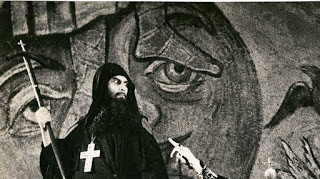
Filipp, in contrast, wants nothing more than to retire from the court altogether. When Ivan lures him by dangling the power represented by the metropolitanate, Filipp gives in to temptation but also formulates a moral argument against Ivan’s excesses. Although he doesn’t succeed in deflecting Ivan onto a better moral path—at least not for long—he “gets into Ivan’s head,” as we might say today, causing Ivan to doubt himself and unleashing the extravagant bouts of repentance that punctuate the tsar’s descent into ever more extreme abuses of power, even after Ivan reverts to the crudest method of silencing his former friend: ordering Filipp’s strangulation.
Eisenstein makes similar use of other characters. Ivan’s aunt, who bears little or no resemblance to the historical princess of Staritsa, wants power too, but for her son more than herself—although we all know who will wield that power if she gets it, because her son is presented as a buffoon. Like Ivan’s wife, his aunt cares about relationships, something Ivan has no compunction about destroying. That wife adores him, although she can’t quite resist Kurbsky’s seductive gaze. The members of Ivan’s private army adore him too, even as their homosocial extravaganzas introduce elements of gender diversity that intertwine with the theme of power in the persons of King Sigismund of Poland and the (never filmed) Queen Elizabeth I of England, whom the historical Ivan IV once petitioned for asylum and whose lady-in-waiting he sought to marry.

It’s a clever tactic, and it works, even though the exaggerated acting and cinematography often seem cartoonish today. But the deeper point is that a quick look reveals a similar process at work in many works of fiction, cinematic and otherwise. In Song of the Siren, for example, the fundamental question is how to handle past and present injuries. Juliana has physical damage caused by smallpox, but the real hurt lies in her soul, the result of decisions made by others when she was very young. Felix, in contrast, has a clear physical disability, which does affect his sense of himself and his worth but is largely offset by the support of a loving family, a comfortable lifestyle, and a rewarding career. Alexei’s wounds are largely laid out and resolved in the previous series, but the effect of those wounds on his past relationship with Juliana enliven their interactions here. Koshkin goes about the world in blinders, oblivious to the damage he inflicts on himself and others. I could draw such parallels for any of my novels.
In this sense, stories involve casts of characters rather than individuals: a kind of hive mind that gives rise to distinct and credible people who happen to be working on different facets of a single problem. That reality, more than anything else, blends a series of solo performances into a single connected whole.
And if you’d like to learn more about the fugue of characters in Song of the Siren, including why I wrote it and which parts are fiction and which not, you can hear me talking about the book with Galit Gottlieb on New Books in Literature. Transcript and interview also on the Literary Hub as of Friday, Mar. 29, 2019: https://lithub.com/spying-on-diplomats-through-the-big-red-kremlin-walls/.
Screen shots from Sergei Eisenstein, Ivan the Terrible, parts 1 and 2: Andrei Kurbsky swearing allegiance; Metropolitan Filipp (Fyodor Kolychev) taking a stand; the members of Ivan the Terrible's private army celebrating together.
Published on March 29, 2019 06:00
March 22, 2019
Filming for Joseph the Terrible
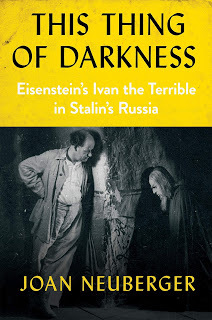 In its early years, the Bolshevik regime wanted to burst all the bounds and set off in new directions—political, social, and cultural. The Communists aimed to create a new world and a new Soviet Man, and nothing from the past could get in the way of that bright future.
In its early years, the Bolshevik regime wanted to burst all the bounds and set off in new directions—political, social, and cultural. The Communists aimed to create a new world and a new Soviet Man, and nothing from the past could get in the way of that bright future. But by the 1930s, as Joan Neuberger reminds us in her interview on New Books in Historical Fiction, Joseph Stalin had second thoughts about the wisdom of tearing down the old to build the new. As tensions between the Third Reich and the USSR escalated, he ordered the revival—in a new, socialist garb—of heroes from the imperial and earlier periods. Including, somewhat improbably, Ivan IV “the Terrible” (r. 1533–84), the first tsar of the lands then called Rus. As part of this campaign, in January 1941 (just five months before Hitler’s army invaded the Soviet Union) Stalin ordered Sergei Eisenstein to direct an epic tale depicting how, against all opposition, Tsar Ivan created the Great Russian State.
The results were not quite what Stalin expected. Eisenstein, a master filmmaker from that early period of cultural experimentation who believed that history (personal and state) proceeded in spirals and bisexuality was humanity’s natural state, dove headfirst into Ivan’s troubled childhood—the subject of my Legends and Songs of Steppe & Forest series—looking for clues to Ivan’s psyche. What made him terrible (that is, terrifying—it’s an old translation using a word that has changed its meaning since the mid-sixteenth century), in effect.

And Eisenstein found answers, which he then put on the screen, with the result that the first part of his trilogy was acclaimed, the second banned, and the third never filmed. Joan Neuberger explains how, and why, all of that happened. It’s a portrait of tyranny, exposed and experienced, and definitely well worth your time. Because it also shines a light on how great works of art are created, including historical fiction.
The rest of this post comes from New Books in Historical Fiction.
Most of the time, this podcast focuses on the products of those who create historical fiction—specifically, novels. But what goes into producing a work of historical fiction—especially in a dictatorship where the wrong choice, or even the right choice at the wrong moment, can send the unwitting author to the Gulag? And what if the creator is not an unknown toiling in the dark to produce manuscripts “for the desk drawer,” as the Soviet literati used to say, but the nation’s foremost filmmaker operating at the personal behest of Joseph Stalin? Such is the dilemma that faces Sergei Eisenstein in 1941, when he begins his unfinished trilogy Ivan the Terrible, an epic ordered by the Soviet government to glorify the Russian past and justify state terror.

Often written off, especially in the West, as a toady to Stalin, Eisenstein—as Joan Neuberger nimbly shows in her new and fascinating study, This Thing of Darkness: Eisenstein’s Ivan the Terrible in Stalin’s Russia (Cornell University Press, 2019)—approached his complicated and risky project with a mixture of enthusiasm and caution. Over the course of five years, despite complaints about budget overflows and production delays, through exile and war and shifts in the party line, personal conflicts and health problems, Eisenstein skillfully alternated between tactics of submission and defiance in support of his idiosyncratic but richly textured portrayal of a tortured autocrat whose childhood traumas led him to ever more extreme exercises of power, even as his excesses stripped him of friends and family, leaving him alone against the endless, unstoppable waves—of progress? of the future? of his own battered conscience? Only the viewer can decide.
Part I won the Stalin Prize, the USSR’s highest honor, although not without controversy. Stalin personally banned Part II before release, and Eisenstein died with Part III unfinished. In this master work about a master filmmaker, Neuberger shines a light on all three. In doing so, she highlights the many decisions any author must make while balancing historical accuracy against dramatic potential and character motivation against a verifiable past. Fortunately, for most of us the stakes are nowhere near as high as they were for Sergei Eisenstein.
Images: Screen shots of Ivan IV “the Terrible” (Nikolai Cherkasov) and King Sigismund II Augustus of Poland-Lithuania (Pavel Massalsky) from Sergei Eisenstein, Ivan the Terrible. Reproduced according to the fair use doctrine.
Published on March 22, 2019 06:00
March 15, 2019
Off to the Races
With
Song of the Siren
(Songs of Steppe & Forest 1) making its way in the world, and Songs 2 with its beta readers, waiting for critique and a final polish (or three), I have time on my hands to consider what’s next in this series. From the moment I started this project, I knew that I wanted to write at least one novel about the two Sheremetev sisters, linked to Nasan in several ways but most simply by having lived next door to her throughout most of her time in Moscow.
Indeed, the inspiration to tell their story was what caused me to undertake Songs of Steppe & Forest in the first place, even if I then chose to explore the lives of Juliana and Grusha first. So theirs was the book I sat down to plan as soon as I had sent Song of the Shaman off by print and e-mail.
Now, as I’ve mentioned elsewhere, “plan” is something of a misnomer when it comes to my writing. Whether I put a lot of work into the planning stage or hardly any, when I sit down at my computer, the same thing happens: the story takes on a life of its own, and within five pages (on average), the characters have headed off happily in whatever direction pleases them while I watch, listen, and record.
That said, these days I do find it useful to construct a set of character profiles and a list of potential story events before diving in. Not because I know who my people really are or how they’ll get where they’re going—what fun is that?—but because it helps to have an ongoing sense of where they’ll end up and some reminders of what’s happening in the historical background so that if they head off into the woods and get lost, I can haul them out again in short order.
It’s also easier to see, when a story is a list of eighteen to twenty events instead of 300 pages, whether it has enough conflict and drama to sustain a novel. Same thing with the characters: if their goals are weak or poorly defined and their personalities one-sided, they need more work even before they get a chance to strut their stuff on the page.
 So for the last couple of weekends, this is what I’ve been doing with Songs 3—and, as it turns out, Songs 4, because I realized early on that the book would become too complicated and diffuse if I had to follow both sisters at the same time, especially if I attempted overlapping first-person narratives. Hence Song of the Sisters (3) will set up a series of conflicts, of which it will resolve about half. The rest can percolate into the newly titled sequel, Song of the Sinner, and find their resolution there.
So for the last couple of weekends, this is what I’ve been doing with Songs 3—and, as it turns out, Songs 4, because I realized early on that the book would become too complicated and diffuse if I had to follow both sisters at the same time, especially if I attempted overlapping first-person narratives. Hence Song of the Sisters (3) will set up a series of conflicts, of which it will resolve about half. The rest can percolate into the newly titled sequel, Song of the Sinner, and find their resolution there.
Which brings me to what I’ve discovered about the Sheremetev sisters so far. The older sister—Solomonida, now thirty-one—appeared quite often in bit parts throughout Legends of the Five Directions, so readers of that series will recognize her. After a disastrous marriage to Daniil Kolychev’s brutish cousin Semyon, Solomonida secured a divorce when Semyon fell foul of the government, and ever since she’s been refusing to enter a convent—the proper fate of a divorced or widowed woman in her culture. Her excuse is that she needs to bring up her daughter, Anna, and see her suitably settled, but the truth is that Solomonida hasn’t the slightest interest in taking monastic vows and never will.
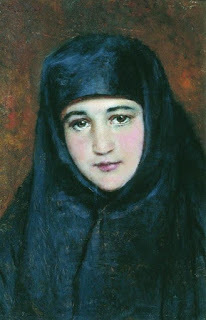 Not so her half-sister Darya, who has successfully dodged one potential marriage partner and has devoted her last five years to caring for her and Solomonida’s bedridden father. She won’t be as familiar to readers, as she made only a cameo appearance in The Golden Lynx. Here, with her father gone, a male cousin shows up at the door intent on taking possession of the sisters’ estate. He’s determined to marry Darya off, even if it means wedding her himself, and she can attain her dearest wish—the opposite of Solomonida’s, for Darya longs to become a nun—only if she defies a lifetime of training in the virtues of female obedience. Even Solomonida can’t understand why Darya would prefer to retire from the world, and the one person in whom she does confide turns out to have ulterior motives.
Not so her half-sister Darya, who has successfully dodged one potential marriage partner and has devoted her last five years to caring for her and Solomonida’s bedridden father. She won’t be as familiar to readers, as she made only a cameo appearance in The Golden Lynx. Here, with her father gone, a male cousin shows up at the door intent on taking possession of the sisters’ estate. He’s determined to marry Darya off, even if it means wedding her himself, and she can attain her dearest wish—the opposite of Solomonida’s, for Darya longs to become a nun—only if she defies a lifetime of training in the virtues of female obedience. Even Solomonida can’t understand why Darya would prefer to retire from the world, and the one person in whom she does confide turns out to have ulterior motives.
Is that enough to get started, even with the addition of the complicated politics roiling the Russian court in the summer and fall of 1543? I think not quite. A heroine who refuses to speak up for herself, even in defense of her own best interests, strikes me as too passive to carry a book. If nothing else, there’s a danger she’ll bore me to tears. So even though I’ve written an opening scene, I have a few more rounds of character wrestling to do before I really stand back and let the imaginary people take over. But it won’t be long, because I can already sense them chomping at the bit, eager to hear the sound of the gate releasing them to race. And if they turn out like Juliana and Grusha, I can expect them to give me quite a run for my money.
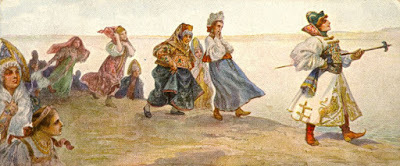
If any of you missed my post on Elena Glinskaya, her death, and the surprising results of her recent exhumation, it went up again this week on the history blog Not Even Past. Big thanks to Joan Neuberger, who runs the site, and from whom you’ll hear more next week.
And thanks, too, to G. P. Gottlieb, who interviewed me today for New Books in Literature. Stay tuned for that link, where you can find out more about Song of the Siren, as well as some of its predecessors.
Images: Konstantin Makovsky, The Young Nun; Sergei Solomko, Young Woman in a Hat; and Sergei Solomko, In Pursuit of Happiness, all public domain via Wikiart.org.
Indeed, the inspiration to tell their story was what caused me to undertake Songs of Steppe & Forest in the first place, even if I then chose to explore the lives of Juliana and Grusha first. So theirs was the book I sat down to plan as soon as I had sent Song of the Shaman off by print and e-mail.
Now, as I’ve mentioned elsewhere, “plan” is something of a misnomer when it comes to my writing. Whether I put a lot of work into the planning stage or hardly any, when I sit down at my computer, the same thing happens: the story takes on a life of its own, and within five pages (on average), the characters have headed off happily in whatever direction pleases them while I watch, listen, and record.
That said, these days I do find it useful to construct a set of character profiles and a list of potential story events before diving in. Not because I know who my people really are or how they’ll get where they’re going—what fun is that?—but because it helps to have an ongoing sense of where they’ll end up and some reminders of what’s happening in the historical background so that if they head off into the woods and get lost, I can haul them out again in short order.
It’s also easier to see, when a story is a list of eighteen to twenty events instead of 300 pages, whether it has enough conflict and drama to sustain a novel. Same thing with the characters: if their goals are weak or poorly defined and their personalities one-sided, they need more work even before they get a chance to strut their stuff on the page.
 So for the last couple of weekends, this is what I’ve been doing with Songs 3—and, as it turns out, Songs 4, because I realized early on that the book would become too complicated and diffuse if I had to follow both sisters at the same time, especially if I attempted overlapping first-person narratives. Hence Song of the Sisters (3) will set up a series of conflicts, of which it will resolve about half. The rest can percolate into the newly titled sequel, Song of the Sinner, and find their resolution there.
So for the last couple of weekends, this is what I’ve been doing with Songs 3—and, as it turns out, Songs 4, because I realized early on that the book would become too complicated and diffuse if I had to follow both sisters at the same time, especially if I attempted overlapping first-person narratives. Hence Song of the Sisters (3) will set up a series of conflicts, of which it will resolve about half. The rest can percolate into the newly titled sequel, Song of the Sinner, and find their resolution there.Which brings me to what I’ve discovered about the Sheremetev sisters so far. The older sister—Solomonida, now thirty-one—appeared quite often in bit parts throughout Legends of the Five Directions, so readers of that series will recognize her. After a disastrous marriage to Daniil Kolychev’s brutish cousin Semyon, Solomonida secured a divorce when Semyon fell foul of the government, and ever since she’s been refusing to enter a convent—the proper fate of a divorced or widowed woman in her culture. Her excuse is that she needs to bring up her daughter, Anna, and see her suitably settled, but the truth is that Solomonida hasn’t the slightest interest in taking monastic vows and never will.
 Not so her half-sister Darya, who has successfully dodged one potential marriage partner and has devoted her last five years to caring for her and Solomonida’s bedridden father. She won’t be as familiar to readers, as she made only a cameo appearance in The Golden Lynx. Here, with her father gone, a male cousin shows up at the door intent on taking possession of the sisters’ estate. He’s determined to marry Darya off, even if it means wedding her himself, and she can attain her dearest wish—the opposite of Solomonida’s, for Darya longs to become a nun—only if she defies a lifetime of training in the virtues of female obedience. Even Solomonida can’t understand why Darya would prefer to retire from the world, and the one person in whom she does confide turns out to have ulterior motives.
Not so her half-sister Darya, who has successfully dodged one potential marriage partner and has devoted her last five years to caring for her and Solomonida’s bedridden father. She won’t be as familiar to readers, as she made only a cameo appearance in The Golden Lynx. Here, with her father gone, a male cousin shows up at the door intent on taking possession of the sisters’ estate. He’s determined to marry Darya off, even if it means wedding her himself, and she can attain her dearest wish—the opposite of Solomonida’s, for Darya longs to become a nun—only if she defies a lifetime of training in the virtues of female obedience. Even Solomonida can’t understand why Darya would prefer to retire from the world, and the one person in whom she does confide turns out to have ulterior motives.Is that enough to get started, even with the addition of the complicated politics roiling the Russian court in the summer and fall of 1543? I think not quite. A heroine who refuses to speak up for herself, even in defense of her own best interests, strikes me as too passive to carry a book. If nothing else, there’s a danger she’ll bore me to tears. So even though I’ve written an opening scene, I have a few more rounds of character wrestling to do before I really stand back and let the imaginary people take over. But it won’t be long, because I can already sense them chomping at the bit, eager to hear the sound of the gate releasing them to race. And if they turn out like Juliana and Grusha, I can expect them to give me quite a run for my money.

If any of you missed my post on Elena Glinskaya, her death, and the surprising results of her recent exhumation, it went up again this week on the history blog Not Even Past. Big thanks to Joan Neuberger, who runs the site, and from whom you’ll hear more next week.
And thanks, too, to G. P. Gottlieb, who interviewed me today for New Books in Literature. Stay tuned for that link, where you can find out more about Song of the Siren, as well as some of its predecessors.
Images: Konstantin Makovsky, The Young Nun; Sergei Solomko, Young Woman in a Hat; and Sergei Solomko, In Pursuit of Happiness, all public domain via Wikiart.org.
Published on March 15, 2019 06:00
March 8, 2019
Familiar Spirits
 A late and short post today, due to the combination of a manuscript that had to get done (work, not novel-related) and the dreaded annual performance self-assessment, transferred to the Web this year for maximum inconvenience. I love almost every part of my job, but filling in meaningless forms is one element I can do without. It’s not as if the people I work with will fail to notice if I suddenly go AWOL and nothing gets done.
A late and short post today, due to the combination of a manuscript that had to get done (work, not novel-related) and the dreaded annual performance self-assessment, transferred to the Web this year for maximum inconvenience. I love almost every part of my job, but filling in meaningless forms is one element I can do without. It’s not as if the people I work with will fail to notice if I suddenly go AWOL and nothing gets done.Still, I did have some fun this week—in addition to the manuscript, which was fascinating, and an interview with Joan Neuberger about her new book on Sergei Eisenstein’s Ivan the Terrible film trilogy, which should go up on New Books in Historical Fiction sometime next week or the week after.
On which, the Literary Hub put up a transcript of last week’s interview with Kate Quinn just yesterday, and you can find that here: . Wonderful picture of the Soviet women pilots who play such an important role in Quinn’s book.

But the main point of today’s post is Stacey Halls’ new book, The Familiars , released on February 19. (The same day as Song of the Siren , as it happens.) It looks at what we might consider the British equivalent of the Salem Witch Trials, held in or near Pendle Hill in Lancashire, in 1612, and it asks a question to which anyone with a knowledge of Stalin’s show trials can relate: Why would someone confess to a crime that she knows will lead to her execution? Did the witches really believe in their own power? Did they just give in to outside pressure or despair at the certain knowledge that they could not expect acquittal? Were threats made against those they loved?
The story is told from the perspective of Fleetwood Shuttleworth, a historical character who although she has been married for several years (despite being only seventeen) and has started three pregnancies, has not given birth to a living child. Now she is pregnant again, and she comes across a letter from her doctor to her husband, warning him that this, her fourth pregnancy, will kill her.
Understandably distraught, Fleetwood runs from the house. In her own woods, she encounters a young woman named Alice Gray, a skilled midwife and herbalist who agrees to help Fleetwood birth her child without sacrificing her own life. But as accusations of witchcraft sweep up the local wise women and a friend of Fleetwood’s husband takes it as his mission to stamp out all potential witches in the area, Alice’s skill with plants brings her under suspicion.
As neighbors and family members turn against one another, the situation becomes ever more dangerous. Even Fleetwood’s relationship with her dog leaves her open to accusations of consorting with a “familiar”—a servant of the Devil in animal form. When Alice is arrested, Fleetwood fights to save her, but the odds are stacked against them. And as Fleetwood’s pregnancy develops, her already troubled marriage continues to disintegrate.
This beautifully written debut novel asks hard questions, but its style is fluid and compelling, its characters—especially Fleetwood and Alice—sympathetic with no trace of sentiment. Definitely a find.
My thanks to Shara Alexander of MIRA Books, who sent me a review copy of this novel with no obligation on me to post a review. As always, the opinions expressed here are entirely my own.
And to all my female readers, Happy International Women’s Day!
Published on March 08, 2019 13:23
March 1, 2019
Hunters and Hunted
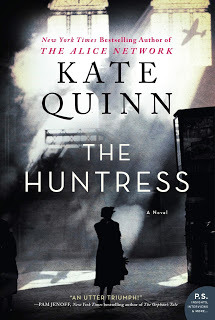 To find a new angle on a topic as saturated with fictional and nonfictional treatments as World War II is a challenge for any author. As Kate Quinn mentions during my most recent New Books in Historical Fiction interview, the war is garnering a great deal of attention at the moment, perhaps because the last members of the generation that lived and fought through it are passing away.
To find a new angle on a topic as saturated with fictional and nonfictional treatments as World War II is a challenge for any author. As Kate Quinn mentions during my most recent New Books in Historical Fiction interview, the war is garnering a great deal of attention at the moment, perhaps because the last members of the generation that lived and fought through it are passing away.It’s all the more remarkable, therefore, that Quinn does uncover such an angle in her latest novel, The Huntress , released earlier this week. In fact, it would be fair to say that she uncovers three or four different angles, which perhaps explains why her book provides such a good read.
The first detour from conventional approaches to World War II is Quinn’s decision to focus on a female war criminal, not one of the usual leaders or even camp guards, and to pick up her story at the moment when she goes on the run to escape arrest and prosecution at Nuremberg. After an initial short scene from the point of view of this character, the Huntress of the title, we move to the perspective of Jordan, a seventeen-year-old American presented with a new stepmother and stepsister. It’s 1946, and Jordan, a typical American schoolgirl with no direct experience of the war—or, indeed, much experience of life—represents another new angle on the story.
Jordan’s new family members appear to conceal more than a few secrets and sometimes behave in puzzling ways. But what fugitive from the war zone doesn’t have memories she’d rather forget? And the new stepmother is, on the whole, loving and kind. She revitalizes Jordan’s lonely father and even supports Jordan’s own desire to attend college and become a photographer. The new stepsister is even more adorable, winning Jordan’s heart from the moment of their first meeting. Jordan chides herself for her suspicious nature and tries to push her sense of something “off” into a back corner of her mind where it belongs.
This brings me to the third and fourth elements that set this novel apart. From Jordan’s introduction to her new stepmother, we move forward four years to make the acquaintance of Ian Graham, a British war correspondent turned war crimes investigator, who’s intent on tracking down the Huntress and bringing her to justice, not least for the murder of his brother. He receives assistance from his green-card wife, Nina Markova—a former lieutenant in the Soviet Air Force bomber regiment known to its enemies as the Night Witches. Because Nina, it turns out, is the only survivor of the Huntress’s atrocities and thus the only person who can identify their quarry by sight. And how that happened takes us back to Nina’s girlhood on the shores of Lake Baikal in Siberia and forward through her military career and the sequence of events that lead to her encounter with the Huntress.
To say more would be to give away too many details of this wonderfully complex and beautifully realized story. Suffice it to say that the overlapping threads all come together in a satisfying conclusion. So listen to the interview, read the transcript, and most of all, buy the book. You won’t regret it.
The rest of this post comes from New Books in Historical Fiction.
When we think of World War II, we envision a catastrophe of massive proportions: millions killed in concentration camps, on the battlefield, during bombing raids and in the nuclear explosions that ended the war. But World War II can also be seen as a vast collection of small catastrophes—a dozen executions or experiments here, a casual act of antisemitism or cruelty there—committed by otherwise ordinary people who either had no moral compass to start with or lost their bearings in an environment that brought out the worst in them. That insight drives The Huntress (William Morrow, 2019), Kate Quinn’s fast-moving, compelling mystery about Nazi hunters in the decade after VJ Day.
Ian Graham, a British war correspondent, is chasing an escaped Nazi known only as die Jägerin, the Huntress. He is determined to see her tried for her crimes, and his motives are both professional and personal: she murdered his younger brother, as well as a dozen Polish children. With the help of the intrepid Nina Markova, former lieutenant of the Night Witches and the only survivor who can identify the Huntress by sight, Ian follows his quarry’s trail across the Atlantic.
Meanwhile, in Boston, seventeen-year-old Jordan McBride welcomes Anneliese, soon renamed Anna—the love interest her lonely father brings home. A budding photographer, Jordan wants first and foremost to go to college, a goal that Anna supports but Jordan’s father overrules. He considers higher education unnecessary for a young woman in 1946, especially one with marriage plans in her future. But the camera does not lie, and Jordan’s photographs soon raise questions about what Anna really left behind when she fled Europe the year before. And before long, Jordan has to wonder why Anna seems so eager to get her new stepdaughter out of the house.
Published on March 01, 2019 07:00
February 22, 2019
The Black Ascot
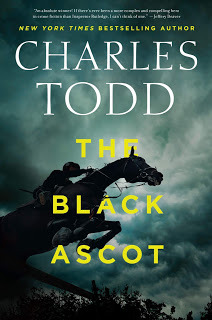 If there’s one thing better than finding a new author you love, it’s discovering an author you love who’s written a good number of novels already. So it is with The Black Ascot (William Morrow Books, 2019) and the mother/son team writing under the pen name Charles Todd, who somehow escaped my attention all these years despite their having produced more than thirty books, most of them mysteries and many of those historical.
If there’s one thing better than finding a new author you love, it’s discovering an author you love who’s written a good number of novels already. So it is with The Black Ascot (William Morrow Books, 2019) and the mother/son team writing under the pen name Charles Todd, who somehow escaped my attention all these years despite their having produced more than thirty books, most of them mysteries and many of those historical.Now, no offense to my own mother and son, but writing a book with either a parent or a child is the last thing I can imagine wanting to do. More power to Charles Todd that they pull it off so well.
The story opens in June 1910, at an event later known as the “Black Ascot.” King Edward VII has just died, and to honor his memory, all the attendants at the annual races arrive dressed in mourning clothes. Quite a spectacle in and of itself, but the Ascot Races are just the beginning. We see them from the perspective of one Alan Barrington—also in mourning, but in his case less on behalf of King Edward than for his friend, Mark Thorne, a recent suicide. And perhaps for his friend’s wife, Blanche, whom Barrington loves and who has just married another man.
That makes twice that she’s chosen someone else over Barrington himself. The scene ends with Barrington heading for the parking lot, filled with horse-drawn carriages and motorcars, looking for one vehicle in particular. We soon learn that Blanche doesn’t survive the trip back to London, and her new husband suffers life-threatening and permanent injuries. Blame falls on Barrington, who had both motive and opportunity. But Barrington escapes justice by fleeing abroad.
Fast forward ten years, to January 1921. A Scotland Yard inspector named Ian Rutledge happens on a hostage taking in an English village, which he succeeds in resolving without harm to the victim. In gratitude, the former hostage’s uncle reveals that he saw Alan Barrington recently in Wales. And the hunt is on.
It would be churlish to reveal the many ins and outs of Rutledge’s hunt as he travels around England searching not just for Barrington but for any evidence that Barrington even returned from abroad. Suffice it to say that the mystery is well crafted, tension-producing, and ultimately satisfying: lots of red herrings, but in the end everything comes together, and we feel we knew the answer all along.
The most interesting element, though, is Ian Rutledge himself. A survivor of the Great War, Rutledge suffers from shell shock, a condition we now call post-traumatic stress disorder (PTSD) and understand to be a normal response to wartime events and similarly intense forms of trauma but that was then considered evidence of cowardice or emotional instability. In Rutledge’s case, it manifests as an internal voice he calls Hamish. Hamish was a real person (real inside the novel, that is), a Scotsman who served under Rutledge in the war and never came home yet who lives on in the detective’s mind. Hamish offers warnings and commentary, expressing Rutledge’s instincts and suspicions, as if delivering messages from the detective’s subconscious. Not that Rutledge himself thinks in such Freudian terms—historical sensitivity is a hallmark of this book—but as readers we recognize that possibility.
It’s a device that gives an appealing complexity to a character who could easily be flat: the quintessential English gentleman, with his repressed emotions and public-school education, his scruples and intellect. And it reveals the level of insight that this pair of authors has into not only their plot but their characters—so often an afterthought in detective fiction. I will definitely be reading more Ian Rutledge mysteries.
Many thanks to Danielle Bartlett of William Morrow Books, who sent me a review copy of this book. There was, however, no obligation on me to post a review, and as always, the opinions expressed here are entirely my own.
And for my own readers, let me also announce with many thanks to Five Directions Press that as of yesterday, Song of the Siren , the first of my new Songs of Steppe & Forest, is available in print and on Kindle. Just click the link to purchase, or check out the publisher’s book page for a description, endorsements, and audio and print excerpts first.
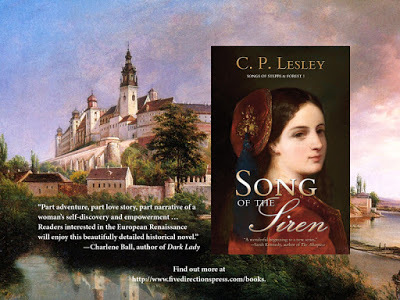
Published on February 22, 2019 06:00
February 15, 2019
Interview with Yangsze Choo
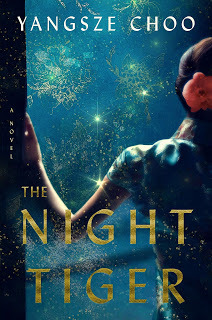 In October 2013, I had the great pleasure of interviewing Yangsze Choo about her debut novel,
The Ghost Bride
. Set among the Chinese community of what was then called Malaya, in the early 1890s, the novel tells the story of Pan Li Lan, the eighteen-year-old daughter of a merchant family fallen on hard times. Desperate to repair his fortunes, Li Lan’s father contracts his daughter to the son of a wealthy local family. Sounds good, but there’s a catch: Pan Li Lan is a ghost bride, married to a dead man. Only a risky and difficult journey through the afterlife can free her from this unwanted bond.
In October 2013, I had the great pleasure of interviewing Yangsze Choo about her debut novel,
The Ghost Bride
. Set among the Chinese community of what was then called Malaya, in the early 1890s, the novel tells the story of Pan Li Lan, the eighteen-year-old daughter of a merchant family fallen on hard times. Desperate to repair his fortunes, Li Lan’s father contracts his daughter to the son of a wealthy local family. Sounds good, but there’s a catch: Pan Li Lan is a ghost bride, married to a dead man. Only a risky and difficult journey through the afterlife can free her from this unwanted bond.I loved the first book, so when I saw on GoodReads that Yangsze had a new novel due out February 12, 2019, I contacted her right away. Because my podcast schedule had no space in it, Gabrielle Mathieu took over the audio interview about The Night Tiger for New Books in Fantasy, and we cross-posted it to New Books in Historical Fiction. But Yangsze also graciously agreed to answer written questions for this blog.
Yangsze, welcome! I so look forward to finding out more about how The Night Tiger came into being. Your first novel, The Ghost Bride, was also set among the Chinese community of Malaysia. What brings you back to this setting, if about fifty years later, for The Night Tiger?
I find it hard to write about places I’ve never been to, perhaps because a novel is like the unfurling of a dream and the reader has to inhabit this world with you. A jarring note causes this dream state to break up and dissolve. The experience of being transported involves intangibles like the color of the sky, the smell of the rain. When I wrote The Ghost Bride, I set it in Melaka, where my uncle used to live. For my second book, I knew I wanted to write about the Kinta Valley, which is further north.
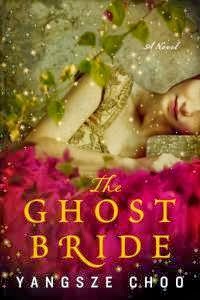 The area around Ipoh in this book is where I spent many childhood visits. It’s where my grandparents lived, and my parents grew up. In fact, my grandfather lived in a long, dark Chinese shophouse very much like the one described in The Night Tiger. You can still see many examples not only in Malaysia but wherever the overseas Chinese diaspora migrated, such as Singapore, Vietnam, and older parts of Hong Kong and Macau. I’ve always been interested in old houses because they retain a visceral sense of history and of stories waiting to be told.
The area around Ipoh in this book is where I spent many childhood visits. It’s where my grandparents lived, and my parents grew up. In fact, my grandfather lived in a long, dark Chinese shophouse very much like the one described in The Night Tiger. You can still see many examples not only in Malaysia but wherever the overseas Chinese diaspora migrated, such as Singapore, Vietnam, and older parts of Hong Kong and Macau. I’ve always been interested in old houses because they retain a visceral sense of history and of stories waiting to be told. Besides old Chinese shophouses, I’m also fascinated by the gracious colonial bungalows, with high ceilings and breezy verandas, left behind by the British. Many have been neglected or torn down, but quite a few have been beautifully restored and turned into hotels or restaurants. Nowadays, almost nobody can afford that sort of lifestyle, which requires a large staff of servants to maintain both the household and the grounds. The lives of those local servants and what they might have seen and thought (an alternate, mirror world to the sort of colonial novel that one tends to read about Southeast Asia—shades of Somerset Maugham!) was another inspiration for The Night Tiger.
The Night Tiger is told from two points of view: Ji Lin speaks in the first person but the past tense, whereas Ren’s story is told in third person present tense. Both of them are vital to the novel, but do you see one as more your main protagonist than the other, and if so which? What can you tell us in a few sentences about him or her?
Ooh! That’s a hard one. I didn’t set out to write a story from two points of view, but I quickly realized it would be hard to cover all the plot twists from one viewpoint. The decision to use third person present tense and first person past tense was fairly deliberate, as I wanted to make both narratives feel close to the reader. You could say that Ji Lin’s narrative is more dominant because it’s in first person. However, I also tried to give Ren’s narrative the quality of vivid honesty that you feel from a child. I actually quite enjoyed Ren’s point of view, in which the reader, as an adult, has the sense that Ren is coming to the wrong conclusions. For example, when Ren tells himself that his master, a British surgeon named William Acton, is “so sane, so reasonable,” the reader, of course, knows that William is actually falling apart.
What we experience through Ren’s eyes and his dreams is also very vivid. A reader told me that he felt the scenes of the railway stations were strangely true. I was happy to hear that, because that’s what I was going for—that feeling when you dream that the dreams are sharper and more meaningful than the real world.
To me, both Ren and Ji Lin are important. And perhaps that’s the point of the book—that all the characters are inextricably entwined together.
The title refers to a local belief in were-tigers, part of a broader category of spirit or sacred animals. What is that belief, and how does it work itself into your novel?
I’ve always been interested in shape-changers and the question of what distinguishes man from beasts. Every culture has its were-creatures. In Europe it is primarily the wolf. In Asia, it’s the tiger or the fox. I find it interesting that it is usually a predator that is said to disguise itself. One doesn’t hear many tales of a were-rabbit, for example.
Shape-shifting is both mysterious and terrifying—the notion that someone isn’t really human at all and is thus no longer subject to the rules and conventions of our civilization. The European werewolf is generally regarded in a negative or fearsome light. In Asia, however, the tiger is revered and sometimes the subject of ancestor worship. Some parts of Indonesia believed that the souls of relatives could pass into a tiger. There’s also the whole notion of keramat or sacred animals, which are said to be guardian spirits.
When I was writing the book, I thought about the contrast between the European idea of a were-creature and the Asian ones, and how in some cases, the were-tiger is not a man but a beast that wears a human skin. That’s such an interesting and creepy thought, which ties in with the whole “who are you?” question that we struggle with.
Ji (Wisdom) and Ren (Benevolence) bear the names of two of the five Confucian virtues. The others—Yi (Righteousness), Shin (Fidelity), and the mysterious Li (Order)—also appear in the novel. Leaving aside Li, whose identity would be a spoiler, who are these characters and why did you decide to use this principle to organize your novel?
You know, I’ve wondered about that myself! I started writing this book the way I started my first novel, with a scene that appeared in my mind. In this case, it was a dying old man who’s asking his eleven-year-old Chinese houseboy, Ren, to do something quite gruesome and sad. Gruesome because it involves recovering severed body parts, and sad because it is a terrible thing to ask of a child. And yet there’s nobility and honor in it. He asks Ren to do it because he thinks he’s saving society; he also believes the boy is capable of the task. So you have all these contradictory emotions together in one place, which is where I think it is best to start a story.
When I began writing this book, I really had no idea how it was going to turn out. I kept writing because I wanted to unravel the mystery. As other characters began to appear, their names actually reminded me of the five Confucian virtues. From there, I somehow got involved with were-tigers and was reminded of the five fingers of a hand, which in many ways is a symbol of our humanity. From cave paintings to space exploration, the expression of our civilization is the outstretched hand, which encompasses both the ability to build and write (plus an opposable thumb).
So I suppose the long answer is that the story grew organically from the Confucian virtues, in a way which often surprised and delighted me. I hope that readers will feel the same way too.
Are you already working on another novel?
Yes, I consider myself a slow writer because it takes time for a story to percolate through, but I’m currently working on my third novel. A lot of the time spent on it is actually trying to inhabit the world of the novel in my head. Only when I feel quite sure about where things are do I start writing. It’s like a mental map. I feel that if you don’t really understand where the book is set, then you can’t take the reader with you. Everything feels vague and out of focus. But when things work out, and the world starts to come together, it’s very exciting!
Thanks so much for answering my questions!
Yangsze Choo is a Malaysian writer of Chinese descent. Her first novel, The Ghost Bride, appeared in 2013 and was a NYTimes bestseller. The Night Tiger is hot off the press as of February 12, 2019.
Follow her on Facebook and Twitter. You can also find out more about her and her books at her website.
Published on February 15, 2019 06:00
February 8, 2019
Behind the Lines
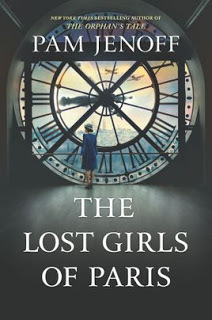 In my latest New Books in Historical Fiction interview, Pam Jenoff answers a question about the main characters in her latest bestseller, The Lost Girls of Paris, by noting that she likes writing books with multiple points of view.
In my latest New Books in Historical Fiction interview, Pam Jenoff answers a question about the main characters in her latest bestseller, The Lost Girls of Paris, by noting that she likes writing books with multiple points of view. I too like writing books with several points of view, as readers of my Legends of the Five Directions novels, especially The Golden Lynx, can attest—and I say that even though my current series uses a single first-person point of view instead. But what are the virtues of choosing one point of view over another?
First person is immediate and intimate (you’re right inside another person’s head). If the author is dealing with a difficult, guarded character—like my Juliana in Song of the Siren—first person opens up the character by revealing what she would never admit to anyone else. But first person is also limited, since no one can be everywhere or do everything. The reader knows only what the narrating character can know. For certain stories, that too can be an advantage, keeping the tension high by hiding plot points and motivations until the right time comes to reveal them.
But a novel like The Lost Girls of Paris absolutely demands not just third person but several points of view. Grace Healey, the first character we meet, has no connection to the main story, except that she discovers a set of photographs and sets out to uncover who the subjects are. She initiates the search, and she exemplifies the world after the war, its long-term effects and memories. But because Grace lives in the United States and we meet her in 1946, she observes past events, acting only at a distance. The role of onsite participant is left to Eleanor Trigg and Marie Roux, each of whom contributes in her own way to the events.
Eleanor supplies context. As the woman in charge of recruiting agents, she understands the larger structure, the planning, the choices being made. It is Eleanor who eventually uncovers the darkness at the heart of the operation—and because of her position it could only be Eleanor. Marie, in contrast, is on the ground, sent behind enemy lines and forced to deal with the consequences of executive decisions in which she has no say and factors that no one, including the heads of the operation, can control.
To oversimplify, Eleanor represents the agency’s brain, whereas Marie is its hands and feet and Grace speaks for its legacy. It’s the shift back and forth among these three perspectives that gives the novel its power, not least because the three women together can go places that each one could not go alone. Each of them also has her own take on the war, based on those experiences, and the blending enriches our perspective as well. That’s the other great benefit of multiple third person: the ability to contrast the insights of different characters, thus giving readers a broader picture of the whole than is possible for one person alone.
For another example of fluid, expressive use of multiple perspectives, don’t miss Yangsze Choo’s new novel, The Night Tiger—the subject of a New Books in Fantasy interview conducted by Gabrielle Mathieu and cross-listed on the New Books in Historical Fiction link below. You can also check back here next Friday, when Yangsze has graciously agreed to answer my questions.
But don’t forget to read the books as well. They’re quite different, but both wonderful—and definitely well worth your time.
As usual, the rest of this post comes from New Books in Historical Fiction.
Although World War II has long been a favorite subject in both literature and history, a new interest seems to have developed in the multiple roles played by women during the war. In The Lost Girls of Paris (Park Row Books, 2019), Pam Jenoff examines from three different fictional perspectives a little-known, real-life British secret service called the Special Operations Executive (SEO). Originally developed to send male saboteurs and radio operators behind enemy lines in France, the SEO had to change its focus when unexpectedly high casualties revealed that men had become so scarce in rural France that its agents were instantly identifiable as people who did not fit in. The director then chose to recruit and send women instead.
The novel opens from the perspective of Grace Healey, detoured into Grand Central Station on her way to work. Grace discovers a suitcase sitting by itself under a bench and, while she’s trying to find out where it belongs, extracts a set of photographs. When she goes to replace them, the suitcase is gone. Grace’s curiosity is piqued, especially when she realizes that a connection exists between the photographs and Eleanor Trigg, whose death in a car crash caused Grace’s detour in the first place.
Eleanor, the second point-of-view character, turns out to have been the head of the female agents at SEO, a job for which she recruits the third character we meet, Marie Roux—a single mother forced to choose between spending time with her daughter and financially supporting her child while serving her country. As we move ever closer, from Grace’s distance in time and place to Eleanor’s founding role to Marie’s experiences on the ground, the danger and the potential for betrayal confronting the SEO agents become increasingly clear.
Published on February 08, 2019 06:00
February 1, 2019
Cat Wars, Take Two
 A couple of years ago, I wrote a post about the adjustments in my household necessitated by the ten-day visit of a new cat, unfamiliar with Siamese cat rules and—at that time—still adjusting to the idea that people also have rules and water squirters to enforce them. If you’d like to read that post, you can find it at “Cat Wars.” But the takeaway was simple: you want to socialize a cat, another cat can do it way better than you can. In short, my senior citizen, then fifteen and a half, licked, hissed, and stared the newcomer into shape in no time flat. The rest of us still had some issues, and the newcomer had issues with us, but the two of them worked things out in splendid style.
A couple of years ago, I wrote a post about the adjustments in my household necessitated by the ten-day visit of a new cat, unfamiliar with Siamese cat rules and—at that time—still adjusting to the idea that people also have rules and water squirters to enforce them. If you’d like to read that post, you can find it at “Cat Wars.” But the takeaway was simple: you want to socialize a cat, another cat can do it way better than you can. In short, my senior citizen, then fifteen and a half, licked, hissed, and stared the newcomer into shape in no time flat. The rest of us still had some issues, and the newcomer had issues with us, but the two of them worked things out in splendid style.Advance a couple of years, and the newcomer, Cat #3, now referred to by the Filial Unit as the “grand-cat,” returned for another stay. The original girlfriend moved out, and another has stepped up to the plate, but the grand-cat remains with the Filial Unit and thus with the family. And while I had some doubts about repeating the socialization experiment, clearly the grand-cat could not remain all alone for almost a month in a small apartment with nothing but an automatic feeder and an occasional visit from friends. So I said sure, bring him along. Sir Percy, in an explosion of fatherly generosity, even drove to collect Filial Unit and cat to prevent any issues with the train.
What happened next was mostly pleasant. The grand-cat had become vastly more mellow as a general rule, due to intensive human intervention, although still a bit trigger-happy with his claws. He came out and roamed about within the first hour and showed considerable resilience, given that he’d been transported against his will into a house that already contained two resident cats. His attempts to scratch couches and walk on counters were mostly controllable with a water squirter, although he never quite gave up on either. And he clearly remembered, if not at once then within a short period of time, the deal he had worked out with Cat #1, now a magnificent seventeen and a half and slowing down a bit, but still capable of telling young whippersnappers to get off his lawn and stay off.
 The surprise this time was Cat #2, the female rescue now approaching ten years old (the newcomer is four at most). She never hid in the closet for days, as she did during the first visit, so she’s either mellowed considerably or she too had some kind of memory that let her start where she left off. However, she did retreat and refrain from any challenge for the first week and a half, letting the boys jockey and strut.Then came Day 10. The three of us mere humans had our morning coffee interrupted by a mind-blowing shriek, mixed with a loud hiss and the unmistakable sounds of cats tussling. From then until the grand-cat left (no doubt thanking his lucky stars to be free of this virago who’d appeared to be such a pussycat [sorry—couldn’t resist that one]), Cat #2 stalked him, attacking at least once a day while the visitor did his darndest to avoid getting on her feline radar. He was perfectly sweet to her, while she went for him every time she saw him. At first I left them to it, figuring they’d work it out. But the day before Cat #3 left, when Cat #2, two-thirds his size, had this fluffy Tuxedo-type bruiser trapped against a wall and refused to back down, I picked her up and carried her off long enough for him to make his getaway. Clearly, no working out was likely to take place in the next twelve hours.
The surprise this time was Cat #2, the female rescue now approaching ten years old (the newcomer is four at most). She never hid in the closet for days, as she did during the first visit, so she’s either mellowed considerably or she too had some kind of memory that let her start where she left off. However, she did retreat and refrain from any challenge for the first week and a half, letting the boys jockey and strut.Then came Day 10. The three of us mere humans had our morning coffee interrupted by a mind-blowing shriek, mixed with a loud hiss and the unmistakable sounds of cats tussling. From then until the grand-cat left (no doubt thanking his lucky stars to be free of this virago who’d appeared to be such a pussycat [sorry—couldn’t resist that one]), Cat #2 stalked him, attacking at least once a day while the visitor did his darndest to avoid getting on her feline radar. He was perfectly sweet to her, while she went for him every time she saw him. At first I left them to it, figuring they’d work it out. But the day before Cat #3 left, when Cat #2, two-thirds his size, had this fluffy Tuxedo-type bruiser trapped against a wall and refused to back down, I picked her up and carried her off long enough for him to make his getaway. Clearly, no working out was likely to take place in the next twelve hours.

So you know what they say: Hell hath no fury like a woman scorned. Or in this case, a girl cat who’s had her territory invaded and has decided she just ain’t gonna take it any more.
Images: Cat #1 enjoying his leisure time; Cat #2 plotting her next foray; Cat #3 in a basket wondering where he went wrong and what he has to do to get the Filial Unit to take him home, where he belongs.
All @ C. P. Lesley.
Published on February 01, 2019 06:00
January 25, 2019
Fitting In--or Not
 Society tends to like people who play by the rules, whatever those rules happen to be at a particular moment. But if everyone played by the rules, the leavening necessary for change would be missing and the benefits of different approaches lost. So many societies also include what we might consider safety valves: roles that exist on the margins, where those who don’t quite fit the current pattern can exist.
Society tends to like people who play by the rules, whatever those rules happen to be at a particular moment. But if everyone played by the rules, the leavening necessary for change would be missing and the benefits of different approaches lost. So many societies also include what we might consider safety valves: roles that exist on the margins, where those who don’t quite fit the current pattern can exist. Grusha, the heroine of my current work in progress, occupies one such role: as a shaman, she enjoys a higher status than that assigned to her at birth, and she provides a service both essential to those with whom she lives and deeply fulfilling in ways she can’t quite articulate. Her challenge, in the novel, is whether to embrace her new identity or return to a family and country she left behind long ago.
I explored several other options for women in a blog series I wrote back in 2013, most obviously in “Taking the Veil.” (From there you can click links within the posts to move back in time through the series.) A convent is also the route to independence taken by Hildegard of Bingen, whom I discussed with P. K. Adams in my previous NBHF interview.
Olivia Givens, the protagonist of Terry Gamble’s just-released novel The Eulogist and the subject of my latest interview on New Books in Historical Fiction, doesn’t have such a formal outlet, but she does face a similar problem. As Terry Gamble notes, Olivia “suffers from opinion”—a statement that in the nineteenth century, and perhaps even today, is not a compliment when applied to women. She is not well matched to the only acceptable social role available to her: that of conventional wife and mother.
Yet despite the considerable odds against her, Olivia does find ways to retain her independence. She marries a doctor whom she’s assisted in performing autopsies. She supports her volatile younger brother, who alternates between revivalist preaching and drunken womanizing. She becomes involved, without entirely meaning to, in helping fugitive slaves in Kentucky cross the Ohio River into freedom. Most of all, she survives to tell her story and that of her family, long after the younger generation has moved on and forgotten.
And what a story it is. Olivia, her brothers, and the rest of her social circle are wonderful characters with quirks and strengths galore. They remind us that even though society prefers those who color within the lines, those who don’t are much more fun to read about.
You can find excerpts from the interview on the Literary Hub. But do listen to the whole thing as well. We had to leave out vast chunks to fit into the 1,500-word limit of the transcript.
Kudos, too, to the designer, who produced that gorgeous and evocative cover of a Victorian woman reflected in the river that plays such a huge role in the story.
As always, the rest of this post comes from New Books in Historical Fiction.
When Olivia Givens and her family leave Ireland in 1819, they have no idea that they are distant victims of a volcanic eruption in Indonesia four years before. They know only that the crops are failing and the aftermath of the Napoleonic Wars have led to the loss of their family property. Fifteen-year-old Olivia has a special reason to want to stay: her first crush on a local boy. But no one listens to a young girl in love, and soon Olivia is standing on the shores of the Ohio River with the rest of her Ulster Protestant family. The city of Cincinnati has just come into being, and that, combined with the illness of Erasmus, the family’s youngest child, convince the Givens to end their journey west in Ohio.
Before long, Olivia’s mother has died in childbirth and her father has abandoned his three surviving children to head south on a paddle boat. James, the eldest son, takes responsibility for his brother and sister. But it’s not the easiest job in the world: Olivia has too much independence of thought to fit neatly into the Victorian vision of “the angel in the house,” and Erasmus cares more for drinking, womanizing, and hanging around with revivalist preachers—even preaching himself—than he does about working in James’s growing candle factory.
Meanwhile, right across the river lies the slave state of Kentucky. As the years go by, the Givens family becomes ever more entangled in helping fugitives cross the water to freedom, whatever the cost to themselves, their lives, and even those they strive to protect.
The Eulogist (William Morrow, 2019) opens a window onto a time when the frontier began at the Mississippi and North and South, although divided by no more than a waterway, occupied different mental and social universes. Terry Gamble’s ability to reveal the many sides of complex conflicts and gift for making even difficult characters appealingly human should not be missed.
Published on January 25, 2019 06:50



